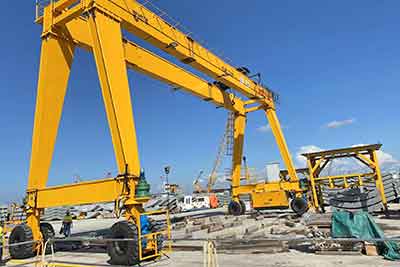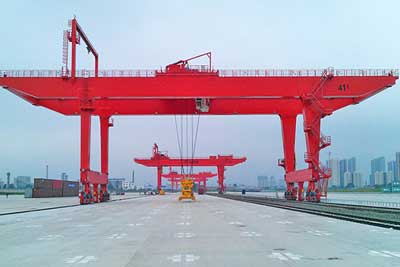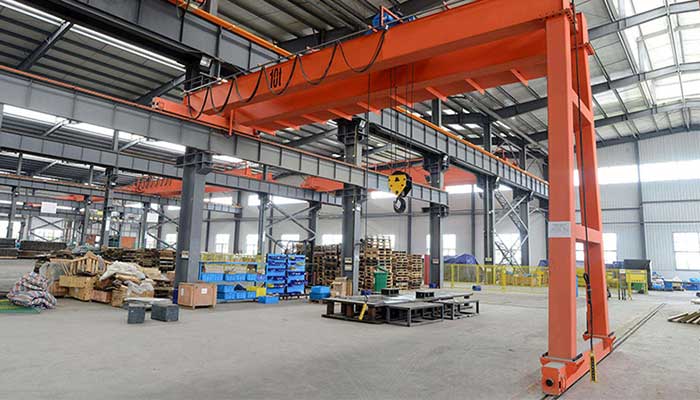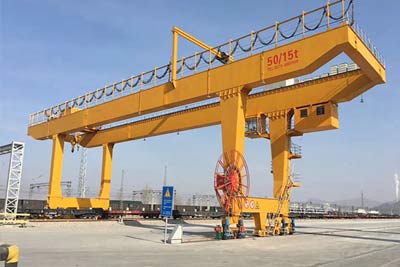Lifting Gantry Cranes for Metro Construction, Solve Your contractor's Concerns
Lifting gantry cranes for metro construction. Full gantry cranes, semi gantry cranes, RMG gantry cranes & RTG gantry cranes solve contractor's concerns.
For metro construction, what are the lifting cranes used on construction sites?
For metro construction, several types of cranes are commonly used on construction sites. Here are some of the most common types of cranes used in metro construction:
- Tower cranes: Tower cranes are commonly used in metro construction for lifting heavy loads to great heights. They are typically mounted on a concrete foundation and can reach up to several hundred feet in height. Tower cranes are ideal for lifting large precast concrete segments, steel beams, and other heavy materials.
- Mobile cranes: Mobile cranes are another type of crane commonly used in metro construction. They are mounted on a truck or crawler and can be easily moved around the job site. Mobile cranes are ideal for lifting heavy loads to moderate heights and can be used for a variety of tasks including material handling and equipment installation.
- Gantry cranes: Gantry cranes are a type of crane that is supported by a gantry system, which consists of two uprights and a horizontal beam. They are commonly used in metro construction for lifting heavy loads over a large area. Gantry cranes can be easily moved around the job site and can be used for a variety of tasks including material handling and equipment installation.
- Crawler cranes: Crawler cranes are a type of mobile crane that is mounted on a set of tracks or crawlers. They are commonly used in metro construction for lifting heavy loads to great heights and can be easily moved around the job site. Crawler cranes are ideal for working on soft or uneven ground where other types of cranes may not be able to operate.
By using the appropriate type of crane for the job, workers can ensure that material handling and lifting operations in metro construction are conducted safely and efficiently.
What are the types of gantry cranes used in the metro construction sites?
There are several types of gantry cranes that are commonly used in metro construction sites. Here are some of the most common types:
- Rubber-tired gantry cranes (RTGs): RTGs are mobile gantry cranes that are mounted on rubber tires. They are commonly used in metro construction sites because they can be easily moved around the job site and do not require a permanent foundation. RTGs are ideal for lifting heavy loads to moderate heights.
- Rail-mounted gantry cranes (RMGs): RMGs are gantry cranes that are mounted on rails. They are commonly used in metro construction sites because they can be easily moved along the rail system and can lift heavy loads to great heights. RMGs are ideal for lifting large precast concrete segments, steel beams, and other heavy materials.
- Portable gantry cranes: Portable gantry cranes are lightweight and easy to move, making them ideal for smaller metro construction sites or for use in areas with limited space. They can be used to lift and move loads vertically or horizontally, and are available in a variety of weight capacities and configurations.
- Container gantry cranes: Container gantry cranes are a type of gantry crane that is specifically designed for lifting shipping containers. They are commonly used in metro construction sites where large amounts of materials or equipment need to be moved quickly and efficiently.
- Semi-gantry cranes: Semi-gantry cranes are a type of gantry crane that is supported by one leg and a runway system. They are commonly used in metro construction sites where space is limited, and can be easily moved along the runway system to lift and move loads.
Rubber tired gantry cranes and rail mounted gantry cranes
Rubber-tired gantry cranes (RTGs) and rail-mounted gantry cranes (RMGs) are mentioned in metro construction because they are both commonly used types of gantry cranes in this type of construction project.


- RTGs are mobile gantry cranes that are mounted on rubber tires, which allows them to move around the job site easily without requiring a permanent foundation. They are ideal for lifting heavy loads to moderate heights and can be used for material handling and transportation of equipment or materials around the job site. In metro construction projects, RTGs may be used to lift and move precast concrete segments, steel beams, or other heavy materials.
- RMGs, on the other hand, are gantry cranes that are mounted on rails. They are commonly used in metro construction projects because they can be easily moved along the rail system and can lift heavy loads to great heights. RMGs are ideal for lifting large precast concrete segments, steel beams, and other heavy materials.
Both RTGs and RMGs offer advantages in terms of mobility and lifting capacity that make them well-suited for use in metro construction projects. By using the appropriate type of gantry crane for the job, workers can ensure that material handling and lifting operations in metro construction sites are conducted safely and efficiently
The choice between a rubber-tired gantry crane and a rail-mounted gantry crane for your metro construction project will depend on factors such as the available space on the job site, the terrain of the job site, and the weight and size of the materials or equipment being lifted. A professional engineer or crane manufacturer can help you determine which type of crane is best suited for your specific project.
Semi gantry crane
Semi-gantry cranes are mentioned in metro construction because they can be a useful type of gantry crane for use in areas where space is limited or where the terrain is uneven. In some metro construction projects, the job site may be located in an area where it is difficult to install a full gantry crane system due to space constraints or other factors. In these situations, a semi-gantry crane can be a practical solution.
Semi-gantry cranes are supported by one leg and a runway system, which allows them to move along the runway to lift and move loads. Because they only require one leg for support, they can be used in areas where a full gantry crane system would not fit or where there are obstacles that would prevent the use of a full gantry crane.
In metro construction projects, semi-gantry cranes may be used to lift and move precast concrete segments, steel beams, or other heavy materials. They can also be used for material handling and transportation of equipment or materials around the job site.
Overall, semi-gantry cranes can be a useful type of gantry crane for use in metro construction projects where space is limited or where a full gantry crane system is not practical.
Container crane
Container cranes are mentioned in metro construction because they can be used to lift and move shipping containers that are used to transport construction materials and equipment to and from the job site. In some cases, metro construction projects may involve the use of large shipping containers to store materials or equipment on site, and container cranes can be used to move these containers as needed.
Container cranes are designed to lift and move heavy loads quickly and efficiently, making them ideal for use in metro construction projects where large amounts of materials or equipment need to be moved quickly. They are typically mounted on rails or other support systems and can be easily moved along the rail system to reach different areas of the job site.
While container cranes are not typically used for lifting and moving precast concrete segments or other heavy materials that are commonly used in metro construction, they can be a valuable tool for moving materials and equipment to and from the job site.
Gantry crane used for a metro construction project be used for another ?
Yes, a gantry crane that is used for a metro construction project can be used for another project, provided that it meets the requirements of the new project. Gantry cranes are versatile pieces of equipment that can be adapted to meet the specific needs of different projects.
However, it is important to ensure that the gantry crane is properly maintained and serviced between projects to ensure that it remains in good working condition. This may involve inspecting the crane for wear and tear, replacing any worn or damaged parts, and conducting any necessary repairs or maintenance.
Additionally, it is important to ensure that the gantry crane is properly certified and meets any regulatory requirements for the new project. This may involve obtaining new certifications or permits, or ensuring that the crane meets any local or national regulations for construction equipment.
Overall, while a gantry crane can be used for multiple projects, it is important to ensure that it is properly maintained, serviced, and certified to ensure that it can be used safely and effectively on each new project.
Can gantry cranes be used in underground material handling of metro construction projects?
Gantry cranes can be used in underground metro construction projects, but they need to be designed to fit the specific requirements and limitations of the underground space.
Things to consider for underground material handling
When the lifting height of a crane covers the depth of an underground area, there are several things that should be noticed to ensure safety:
- Check for underground utilities: Before beginning any excavation work, it is important to check for underground utilities such as gas lines, water pipes, and electrical cables. This will help to prevent accidents and avoid damage to the utilities.
- Ensure proper ventilation: When working in an underground area, it is important to ensure proper ventilation to prevent the buildup of toxic gases. This can be achieved by using ventilation fans or natural ventilation.
- Use proper lighting: Proper lighting is essential when working in an underground area. It is important to use bright, high-quality lighting that illuminates the entire work area.
- Ensure stability of the crane: When using a crane in an underground area, it is important to ensure that the crane is stable and secure. This can be achieved by using outriggers or stabilizers to prevent the crane from tipping over.
- Use proper lifting equipment: When lifting heavy loads in an underground area, it is important to use proper lifting equipment such as slings, chains, and shackles. This will help to ensure that the load is secure and prevent accidents.
- Follow safety guidelines: It is important to follow all safety guidelines and regulations when working in an underground area. This includes wearing appropriate personal protective equipment (PPE) such as hard hats, safety glasses, and gloves, and following safe work practices at all times.
How to confirm the lifting height when your material handling involving above and underground operations?
When material handling involves both above and underground operations, it is important to confirm the lifting height to ensure safety and avoid accidents. Here are some steps to confirm the lifting height:
- Measure the distance: The first step is to measure the distance between the above and underground areas. This can be done using a measuring tape or other measuring tools.
- Determine the maximum lifting height: Once the distance is measured, you can determine the maximum lifting height required for the job. This will depend on the height of the upper area, the depth of the underground area, and any other factors that may affect the lifting height.
- Check for obstructions: Before lifting any materials, it is important to check for any obstructions that may interfere with the lifting process. This includes overhead power lines, tree branches, and other obstacles that may be in the way.
- Use proper lifting equipment: When lifting materials between above and underground areas, it is important to use proper lifting equipment such as cranes, hoists, and slings. This will help to ensure that the materials are lifted safely and securely.
- Follow safety guidelines: It is important to follow all safety guidelines and regulations when working with lifting equipment. This includes wearing appropriate personal protective equipment (PPE), following safe work practices, and ensuring that all equipment is properly maintained and inspected before use.
By following these steps, you can confirm the lifting height and ensure that your material handling operations involving above and underground areas are conducted safely and efficiently.
Factors affect underground material handling
- Safety procedures: Establishing safety procedures for material handling operations involving above and underground areas is critical to prevent accidents and injuries. This may include procedures for inspecting equipment before use, securing loads, and properly positioning workers during lifting operations.
- Communication: Communication between workers on the ground and those operating lifting equipment is essential to ensure that lifting operations are conducted safely and efficiently. Workers on the ground should be able to communicate with equipment operators to provide guidance on load positioning and movement.
- Equipment maintenance: Proper maintenance of lifting equipment is essential to ensure that it is functioning properly and can safely handle loads. Regular inspections, repairs, and replacements of worn or damaged parts can help to prevent accidents and extend the life of the equipment.
- Load capacity: Lifting equipment should only be used to lift loads that are within its capacity. Overloading equipment can result in accidents and damage to the equipment. Workers should be trained to properly assess load weight and ensure that it does not exceed the equipment's capacity.
- Environmental factors: Environmental factors such as weather conditions, temperature, and humidity can affect material handling operations in above and underground areas. For example, high winds can make lifting operations more dangerous, while extreme temperatures can affect the performance of equipment. Workers should be trained to take these factors into account when planning and executing material handling operations.
- Emergency procedures: In the event of an emergency, workers should be trained on procedures for shutting down equipment, evacuating workers, and responding to accidents or injuries. Having clear emergency procedures in place can help to prevent injuries and minimize damage to equipment.
What are the typical lifting equipment used for above and underground material handling and lifting ?
There are several types of lifting equipment that are commonly used for material handling and lifting in above and underground areas. Here are some of the most typical types of lifting equipment:
- Cranes: Cranes are a type of lifting equipment that use a hoist and wire ropes or chains to lift and move heavy loads. They are commonly used for material handling in above and underground areas, and come in a variety of types including tower cranes, mobile cranes, and overhead cranes.
- Hoists: Hoists are a type of lifting equipment that use a chain or wire rope to lift and move loads vertically. They are commonly used in underground areas where space is limited, and are available in electric, hydraulic, and manual models.
- Slings: Slings are a type of lifting equipment that are used to support and lift loads. They are typically made of wire rope, chain, or synthetic materials, and come in a variety of configurations including flat, round, and wire rope slings.
- Aerial lifts: Aerial lifts are a type of lifting equipment that are used to lift workers to elevated work areas. They are commonly used in construction and maintenance settings, and come in a variety of types including scissor lifts, boom lifts, and personnel lifts.
By using the appropriate type of lifting equipment for the job, workers can ensure that material handling and lifting operations in above and underground areas are conducted safely and efficiently.
For metro construction, what is the concerns of contractor and how to solve ?
For contractors working on metro construction projects, there are several key concerns related to lifting equipment. Here are some of the most common concerns:
Safety:
- Safety is the primary concern for contractors working with lifting equipment in metro construction. Workers must be properly trained on how to operate the equipment safely, and safety procedures must be followed at all times to prevent accidents and injuries.
- Contractors should prioritize safety by ensuring that workers are properly trained on how to operate lifting equipment safely, and that safety procedures are followed at all times. This may include providing personal protective equipment (PPE), conducting regular safety inspections, and implementing emergency procedures.
Cost:
- Lifting equipment can be expensive to purchase or rent, and contractors must carefully consider the cost of equipment when planning and budgeting for a project. They must also consider the cost of maintenance, repairs, and replacement parts.
- Contractors can manage costs by carefully planning and budgeting for lifting equipment, including the cost of rental or purchase, maintenance, repairs, and replacement parts. They can also consider sharing equipment with other contractors or renting equipment as needed to reduce costs.
Availability:
- Lifting equipment may not always be available when it is needed, particularly for large or complex projects. Contractors must plan ahead to ensure that the necessary equipment is available when it is needed, and may need to make arrangements with equipment rental companies or other contractors to obtain the required equipment.
- Contractors can ensure that the necessary lifting equipment is available when it is needed by planning ahead and making arrangements with equipment rental companies or other contractors. They can also consider using alternative equipment or methods if the required lifting equipment is not available.
Productivity:
- The productivity of lifting equipment is an important concern for contractors, as it can affect the overall timeline and success of a project. Contractors must ensure that the equipment they use is capable of handling the required loads and that it is used efficiently to avoid delays and downtime.
- Contractors can maximize the productivity of lifting equipment by ensuring that it is properly maintained and used efficiently. This may include scheduling regular maintenance and repairs, optimizing load placement and movement, and using the appropriate type of lifting equipment for the job.
Compliance:
- Contractors must comply with all relevant regulations and standards related to lifting equipment in metro construction. This includes OSHA regulations, ANSI standards, and other guidelines related to safety, load capacity, and environmental factors.
- Contractors can ensure compliance with relevant regulations and standards by staying up-to-date on changes to regulations and guidelines, conducting regular inspections and audits, and providing training on compliance requirements.
By addressing these concerns, contractors can ensure that they are able to work safely and efficiently with lifting equipment in metro construction and complete projects on time and within budget.




